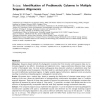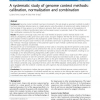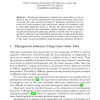112 search results - page 6 / 23 » The Performance of Phylogenetic Methods on Trees of Bounded ... |
GECCO
2006
Springer
13 years 11 months ago
2006
Springer
The most popular approaches for reconstructing phylogenetic trees attempt to solve NP-hard optimization criteria such as maximum parsimony (MP). Currently, the bestperforming heur...
ALMOB
2008
13 years 7 months ago
2008
Motivation: Sequence-based methods for phylogenetic reconstruction from (nucleic acid) sequence data are notoriously plagued by two effects: homoplasies and alignment errors. Larg...
BMCBI
2010
13 years 2 months ago
2010
Background: Genome context methods have been introduced in the last decade as automatic methods to predict functional relatedness between genes in a target genome using the patter...
BMEI
2008
IEEE
14 years 1 months ago
2008
IEEE
Multiple sequence alignment is the most fundamental task in bioinformatics and computational biology. In this paper, we present a new algorithm to conduct multiple sequences align...
CPM
2000
Springer
13 years 11 months ago
2000
Springer
Breakpoint phylogenies methods have been shown to be an effective way to extract phylogenetic information from gene order data. Currently, the only practical breakpoint phylogeny a...



